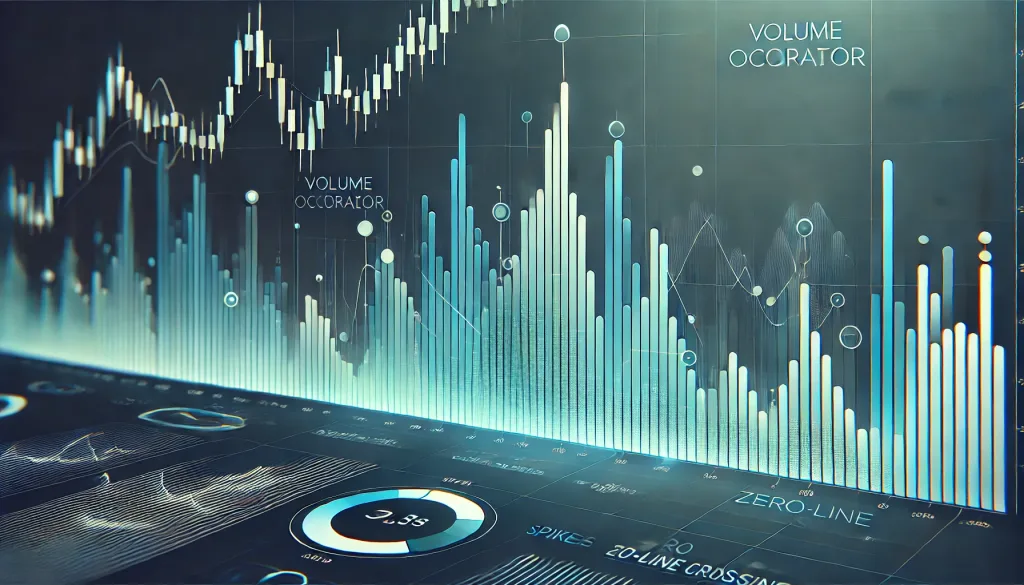Spot Market Trends with the Volume Oscillator on the Daily Timeframe

The Volume Oscillator: A Daily Timeframe Powerhouse
When it comes to mastering the art of Forex trading, the volume oscillator is like that underrated movie everyone eventually raves about. Subtle, powerful, and brimming with hidden potential. Combine it with the daily timeframe, and you’ve got yourself a recipe for spotting trends and avoiding those nasty market traps. Let’s explore how to wield this tool like a pro—with a side of humor and actionable insights.
What is the Volume Oscillator?
The volume oscillator is a technical indicator that measures the difference between two moving averages of volume: a shorter period (fast) and a longer period (slow). The result is presented as a percentage and oscillates around a zero line.
Think of it as your market mood detector. If volume spikes, traders are either rushing in or stampeding out. If it’s flat, the market might be doing its best impression of a lazy Sunday.
Key Features:
- Positive Values: When the shorter MA is above the longer MA, it indicates bullish momentum.
- Negative Values: When the shorter MA is below the longer MA, bearish sentiment prevails.
- Zero Line: The equilibrium, where trends are neutral and indecision reigns supreme.
Why Use the Daily Timeframe?
The daily timeframe is the sweet spot for traders who like their data a little more refined and a lot less noisy. It captures broader market trends while filtering out intraday volatility. Using the volume oscillator on this timeframe gives you a clearer picture of who’s winning the tug-of-war: bulls or bears.
Decoding the Volume Oscillator on a Daily Timeframe
Step 1: Identify Momentum Shifts
When the volume oscillator crosses above the zero line, it signals increasing bullish momentum. Conversely, a dip below zero hints at bearish vibes. Pay attention to these shifts, as they often precede price movements.
Step 2: Spot Divergences
Divergences between price action and the volume oscillator can be game-changers. If prices are rising but the volume oscillator is falling, it’s like seeing a party winding down while the DJ still plays bangers—momentum is fading, and a reversal might be near.
Step 3: Combine with Price Patterns
Pair the volume oscillator with price action patterns like breakouts, double tops, or flags. For example:
- Breakouts: A surge in the volume oscillator confirms the breakout’s validity.
- Reversals: A falling oscillator during a rally hints at exhaustion.
A Real-Life Example: EUR/USD Daily Analysis
In Q3 2023, the EUR/USD pair was stuck in a range. The volume oscillator signaled a positive spike as prices broke above a resistance level, confirming a bullish breakout. Traders who entered early rode a 150-pip rally before the oscillator dipped back near zero, signaling a consolidation phase.
Pro Tips for Mastering the Volume Oscillator
- Set Custom Parameters: Adjust the fast and slow MA periods to suit your trading style. For the daily timeframe, try 5 and 20 periods for a balanced approach.
- Combine Indicators: Pair the volume oscillator with the RSI or MACD for added confirmation. Think of it as having both a map and a compass on your trading journey.
- Stay News-Savvy: Sudden volume spikes often coincide with economic news or central bank announcements. Keep an eye on the calendar to avoid surprises.
- Risk Management: Always use stop-loss orders and position sizing. No indicator is infallible, and the market loves throwing curveballs.
Common Myths About the Volume Oscillator
Myth 1: It’s Only for Experts
Reality: The volume oscillator is user-friendly, making it accessible for both rookies and seasoned traders.
Myth 2: It’s Too Slow
Reality: On the daily timeframe, the oscillator’s lag helps filter out noise, focusing on significant trends.
Myth 3: It Works Alone
Reality: While powerful, the volume oscillator shines brightest when paired with other tools and thorough analysis.
The volume oscillator on the daily timeframe is a potent tool for traders seeking clarity in a chaotic market. By focusing on momentum shifts, divergences, and volume confirmations, you can spot high-probability trade setups with ease. Remember, no indicator is a crystal ball, but with the right strategy, the volume oscillator might just be your new best trading buddy.
—————–
Image Credits: Cover image at the top is AI-generated
PLEASE NOTE: This is not trading advice. It is educational content. Markets are influenced by numerous factors, and their reactions can vary each time.

Anne Durrell & Mo
About the Author
Anne Durrell (aka Anne Abouzeid), a former teacher, has a unique talent for transforming complex Forex concepts into something easy, accessible, and even fun. With a blend of humor and in-depth market insight, Anne makes learning about Forex both enlightening and entertaining. She began her trading journey alongside her husband, Mohamed Abouzeid, and they have now been trading full-time for over 12 years.
Anne loves writing and sharing her expertise. For those new to trading, she provides a variety of free forex courses on StarseedFX. If you enjoy the content and want to support her work, consider joining The StarseedFX Community, where you will get daily market insights and trading alerts.
Share This Articles
Recent Articles
The GBP/NZD Magic Trick: How Genetic Algorithms Can Transform Your Forex Strategy
The British Pound-New Zealand Dollar: Genetic Algorithms and the Hidden Forces Shaping Currency Pairs
Chande Momentum Oscillator Hack for AUD/JPY
The Forgotten Momentum Trick That’s Quietly Dominating AUD/JPY Why Most Traders Miss the Signal
Bearish Market Hack HFT Firms Hope You’ll Never Learn
The One Bearish Market Hack High Frequency Traders Don't Want You to Know The

